Walks | Environment | Schools | Local notes | Links | Supporters | Wednesday Volunteers
Events | News | Newsletter | Contacts | Members | Archive | EASI | Laurel Park Orchard
|
Mammals |
Mammal TrappingSquirrels and foxes are a frequent sight in the Maiden Erlegh nature reserve, but how many other mammals live in around the lake and the adjoining woods and meadows? To gain a glimpse into the secretive world of hedgehogs, rats, mice, voles, shrews and the like, the Earley Environmental Group arranged for humane mammal traps to be set on Friday 8 July and invited members to see what was caught the following morning. Maryanne Thomas, an experienced specialist in mammals led the session. Early on the Friday evening she, and members Grahame, Ricki and Richard, set 18 traps in the lower meadow, downhill from Instow Road towards the lake. Sites were selected around the margins - along the banks and hedgerows - with some in the middle of the flower meadow, to represent a variety of habitats suitable for several species of animal. Each trap was baited with corn (for mice and voles), insect 'casters' (for the carnivorous shrew) and apple (as a source of moisture). They were then placed carefully in the thick vegetation; their locations discreetly marked with an identifying yellow tag on a branch or stalk nearby and recorded on a GPS device.  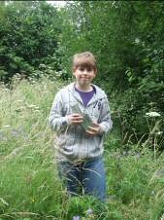
At 9.00 am on the Saturday, 22 members and friends of the Group assembled in Instow Road. As they were gathering a fox made a brief appearance, before turning tail and melting away. Foxes weren't the objective of the day, but a welcome sighting on a mammal morning none-the-less. The intended targets were various types of mice, voles (bank and field voles), and shrews. Maryanne explained the process. To save trampling the wild flowers, only she and Richard would check the traps and retrieve the undisturbed ones. Any that were closed would be brought back to the path, opened, emptied, and then Maryanne would identify the creature and hold it up for examination. The first couple of traps were clearly empty, but the third was closed. Richard brought it back and Maryanne, emptied the remaining food and hay into a large, clear plastic bag. There, among the detritus, was a mouse. Wearing a glove for protection against bites, and as a barrier to the possible transmission of disease, Maryanne isolated the creature and lifted it up by the scruff of the neck. As mice live their lives at a high level of stress, she explained, such treatment would not be an experienced as any particular ordeal; the mouse would not be harmed. This one was a wood mouse, an immature male. 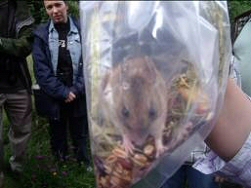 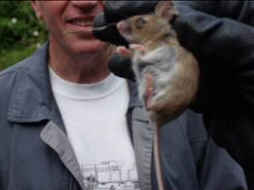
Next was another closed trap. There was little sign of movement within so there was some hope that this might contain a vole, generally a more docile animal. In fact the trap simply was empty. However, the next was not. Comparatively heavy it too was emptied into the bag (which was secured around Mary anne's arm to prevent escapes) and the creature identified as a female wood mouse, possibly pregnant, which would account for the greater weight. 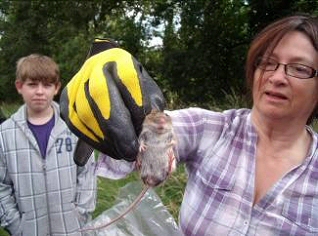 
The raised edge of Oak Wood was reckoned to be a likely place for bank voles, but trap No.6 yielded nothing. Neither did traps No.8 and 9, which were in locations suitable for field voles. Trap No.10 was closed, but the culprit turned out to be a slug. A common frog was found next to No.11. Regrettably none of the others contained rodents. Nos.15 and 16 were closed, but mysteriously empty, while No.17 contained another slug. Perhaps surprisingly, a large slug might weigh more than a mouse or shrew and so can easily set off a trap. 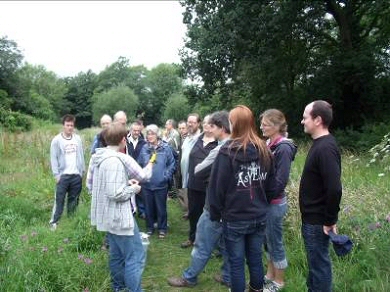
Maryanne explained a little more about the practice of trapping and the patience such a task requires. The sort of trapping carried out at Maiden Erlegh was a presence/absence survey, and the morning's activity had certainly proved the presence of wood mice. Density surveys, on the other hand, require a much greater number of traps, say 100 for an area the size of the meadow, and would be carried out over three days. The traps would be spaced every couple of yards, to account for the very limited territories many animals inhabit. Animals caught would be marked to avoid double counting during the three days. As traps are made of aluminium they are only used during the more temperate conditions of evening and early morning, to avoid cooking the captives. Also shrews in particular eat their bodyweight in food per day, so traps have to be adequately baited to avoid starvation overnight. Asked about her more memorable findings Maryanne recalled a group of baby mice that had been born in the trap at night. They had to be reared in captivity and released when older. Discussing the ability of mice to reproduce so prodigiously, quantifying the number of mammal species to be found in Britain and considering the mammals' role in evolution, the group dispersed through a meadow full of flowers, with butterflies emerging into the sunshine and red kites soaring overhead. Edwin A.R. Trout |